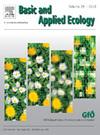资源可利用性和竞争形成了长叶松稀树草原传粉者的营养专门化
IF 3.5
2区 环境科学与生态学
Q2 ECOLOGY
引用次数: 0
摘要
已实现的营养特化,或一个物种与当地相互作用的食物资源,是由物种基本生态位、资源可用性和竞争驱动的。然而,在植物-传粉媒介网络中,资源可用性和竞争对营养特化的同时影响尚未得到研究。本文分析了资源可用性(开花植物多样性和丰度)和传粉者竞争池(传粉者物种丰富度、同种和异种传粉者个体丰度)对传粉者营养特化的影响。利用美国佛罗里达州中北部24个干旱性稀树草原整个花期的样本,分析了植物有效性和传粉者竞争池对植物营养特化的影响:分类特化(植物物种的传粉者选择)、系统发育特化(植物系统发育谱系的传粉者选择)和功能特化(植物功能性状的传粉者选择)。我们的研究结果表明,开花资源和传粉者竞争者池都影响传粉者的营养专业化。个体传粉者通过与更多开花植物相互作用(即,分类上的通才)对传粉者丰富度的提高作出反应,强调了授粉系统对传粉者灭绝的脆弱性(即,当昆虫竞争对手较少时,传粉者访问的植物物种较少)。在具有许多同种传粉者的群落中,传粉者更加专业化,可能反映了传粉者的偏好。最后,在更多样化的开花植物组合中,传粉者是花访问的分类学专家,但在系统发育和功能上是通才,在不同的植物组合中提供传粉服务。本文章由计算机程序翻译,如有差异,请以英文原文为准。
Resource availability and competition shape pollinator trophic specialization in longleaf pine savannas
Realized trophic specialization, or the food resources with which a species interacts locally, is driven by a species fundamental niche, resource availability, and competition. However, the simultaneous effects of resource availability and competition on trophic specialization have yet to be investigated in plant-pollinator networks. Here, we disentangled the effects of resource availability (i.e., blooming plant diversity and abundance), and pollinator competitor pool (i.e., pollinator species richness, and abundance of conspecific and heterospecific pollinator individuals) on pollinator trophic specialization. We used samples collected over an entire flowering season in 24 xeric pine savannas in north-central Florida, USA and evaluated the effects of plant availability and pollinator competitor pool on three aspects of trophic specialization: taxonomic specialization (pollinator selection of plant species), phylogenetic specialization (pollinator selection of plant phylogenetic lineages), and functional specialization (pollinator selection of plant functional traits). Our results show that flowering resources and the pools of pollinator competitors both influence pollinator trophic specialization. Individual pollinators reacted to higher pollinator richness by interacting with more flowering plants (i.e.,taxonomically generalist), underscoring the vulnerability of pollination systems to pollinator extinctions (i.e., pollinators visit fewer plant species when there are fewer insect competitors present). Pollinators were more specialized in communities containing many conspecific pollinators, possibly reflecting pollinator preferences. Finally, in more diverse flowering plant assemblages, pollinators were taxonomic specialists in flower visitation but phylogenetic and functional generalists, providing pollination services across diverse plant assemblages.
求助全文
通过发布文献求助,成功后即可免费获取论文全文。
去求助
来源期刊

Basic and Applied Ecology
环境科学-生态学
CiteScore
6.90
自引率
5.30%
发文量
103
审稿时长
10.6 weeks
期刊介绍:
Basic and Applied Ecology provides a forum in which significant advances and ideas can be rapidly communicated to a wide audience. Basic and Applied Ecology publishes original contributions, perspectives and reviews from all areas of basic and applied ecology. Ecologists from all countries are invited to publish ecological research of international interest in its pages. There is no bias with regard to taxon or geographical area.
 求助内容:
求助内容: 应助结果提醒方式:
应助结果提醒方式:


